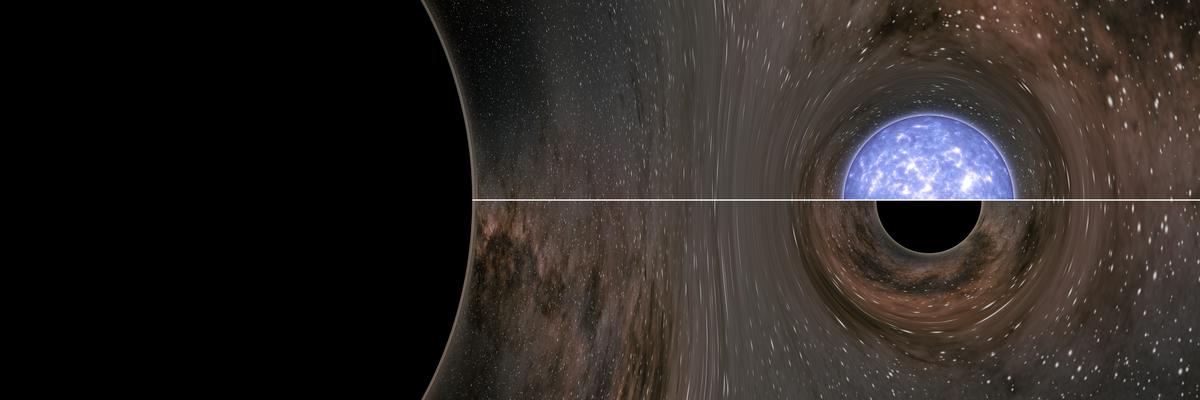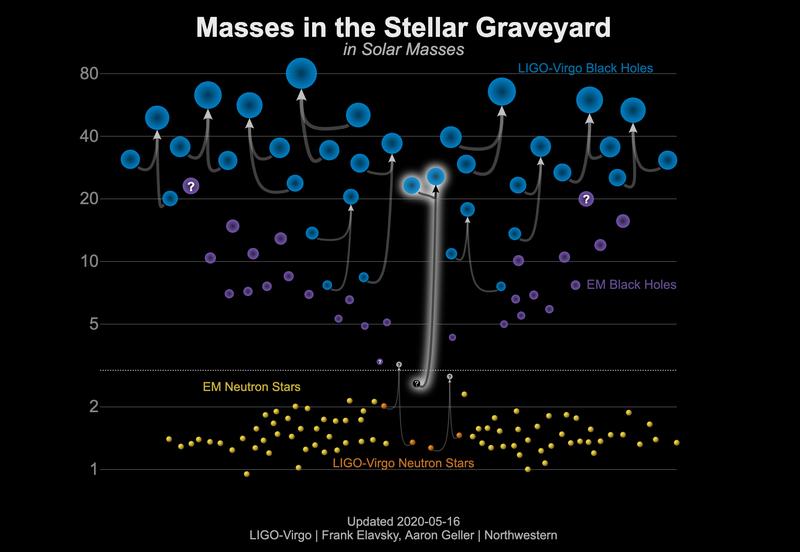Highlight
Virgo and LIGO spot a mystery object merging with a black hole
June 23, 2020

For a long time astronomers have puzzled over the lack of observations of compact objects with masses ranging from 2.5 up to 5 solar masses. This mysterious grey area is known as the ‘mass gap’: a range of masses apparently too light for a black hole and too heavy for a neutron star. Both neutron stars and black holes form when very massive stars run out of their nuclear fuel and explode as supernovae. What is left depends on how much of the star’s core remains. The lighter cores tend to form neutron stars, while the heavier ones collapse into black holes. Understanding whether a mass gap exists in the mentioned range, and why, has been a long-lasting puzzle for scientists.
Now, the scientific collaborations running the Advanced Virgo detector at the European Gravitational Observatory (EGO), near Pisa in Italy, and the two Advanced LIGOs, in the US, have announced the discovery of an object of about 2.6 solar masses, i.e. within the so called ‘mass gap’, thus questioning its very existence. The nature of the object itself remains mysterious, since the gravitational-wave observations alone do not allow us to distinguish whether it is a black hole or a neutron star. About 800 million years ago, the object merged with a black hole of 23 solar masses and, in so doing, generated a final black hole about 25 times the mass of the sun. The merger emitted an intense gravitational wave, which was detected on the 14th of August, 2019, by the three instruments in the network and is hence called GW190814. The discovery has just been published in The Astrophysical Journal Letters.

“Once again, gravitational-wave observations are shedding light on the unknown. The lightest object in this system has a mass that has never before been observed”, says Giovanni Losurdo, of Istituto Nazionale di Fisica Nucleare (Italy) and the spokesperson of the Virgo Collaboration. “A new discovery, which raises new questions. What is its nature? How did such a binary system form? Virgo, LIGO and, soon, Kagra in Japan, will continue to search for the answers and push forward the frontier of what we know about the cosmos in which we live.”
Another peculiarity of this event is that the merger shows the most unusual ratio between the masses of a binary system that has been recorded to date. The larger mass is around 9 times heavier than the smaller mass.
“The detection of these new classes of events also pushes our models and analysis tools to their limits”, says Ed Porter, Virgo Collaboration researcher at CNRS and co-chair of the Compact Binary Coalescence analysis group for the LIGO and Virgo collaborations. “While there is still much that we do not know about this system, the fact that we are observing uncharacteristic systems like GW190814 for the first time in the history of science is what makes gravitational-wave astronomy so exciting.” The signal associated with such an unusual merger was clearly detected by all three of the instruments of the LIGO-Virgo network, with an overall signal-to-noise ratio as high as 25. Thanks mainly to the delay between the signal arrival times at the well-separated detectors, i.e. the two Advanced LIGOs in the US and Advanced Virgo in Italy, the 3-detector network was able to localise the origin of the wave to within about 19 square degrees.
When the LIGO and Virgo scientists spotted this merger, they immediately sent out an alert to the astronomical community. Many ground- and space-based telescopes followed up in search of light and other electromagnetic waves, but, unlike with the famous merger of two neutron stars, detected in August 2017 and which gave birth to so-called multi-messenger astronomy, none picked up any signals.
According to the Virgo and LIGO scientists, the August 2019 event was not seen in light for a few possible reasons. First, this event was six times further away than GW170817, making it harder to pick up any light signals. Second, if the collision involved two black holes, it likely would not have emitted any light. Third, if the smaller object in the system was in fact a neutron star, its 9-fold more massive black-hole partner might have swallowed it whole; a neutron star consumed whole by a black hole would not give off any light.
“I think of Pac-Man eating a little triangle,” says Vicky Kalogera researcher of the LIGO collaboration and a professor at Northwestern University. “When the masses are highly asymmetric, the smaller neutron star can be eaten in one bite.”
The identity of the object detected on the 14th of August, 2019, remains a mystery.
“Explaining the formation of the detected binary system is hard. Its unique combination of mass ratio and masses challenges all current astrophysical models”, explains Mario Spera, Virgo Collaboration researcher at the University of Padova and presently at the Northwestern University. “Furthermore, we suspect that some environments, such as young dense clusters and active galactic nuclei, may increase the number of mergers with such extreme mass ratio. However, what we know for sure and so far, is that the universe is firmly telling us that we are still missing most of the story on the formation and evolution of compact objects and that we likely need to revise some of our current ideas about compact-object formation.”
Future observations with Virgo, LIGO and possibly other telescopes may catch similar events and help us to answer the numerous questions that the GW190814 detection has raised.
Additional information about the gravitational-wave observatories:
The Virgo Collaboration is currently composed of approximately 550 members from 106 institutes in 12 different countries, including Belgium, France, Germany, Hungary, Ireland, Italy, the Netherlands, Poland, Portugal and Spain. The European Gravitational Observatory (EGO) hosts the Virgo detector near Pisa in Italy, and is funded by Centre National de la Recherche Scientifique (CNRS) in France, the Istituto Nazionale di Fisica Nucleare (INFN) in Italy, and Nikhef in the Netherlands. A list of the Virgo Collaboration groups can be found at http://public.virgo-gw.eu/the-virgo-collaboration/ . More information is available on the Virgo website at http://www.virgo-gw.eu . LIGO is funded by the NSF and operated by Caltech and MIT, which conceived of LIGO and lead the project. Financial support for the Advanced LIGO project was led by the NSF, with Germany (Max Planck Society), the U.K. (Science and Technology Facilities Council) and Australia (Australian Research Council-OzGrav) making significant commitments and contributions to the project. Approximately 1,300 scientists from around the world participate in the effort through the LIGO Scientific Collaboration, which includes the GEO Collaboration. A list of additional partners is available at https://my.ligo.org/census.php .
- IFAE Research group
- Gravitational Waves Group
- Contact
